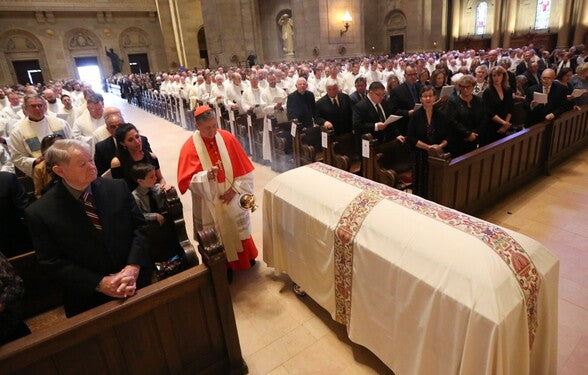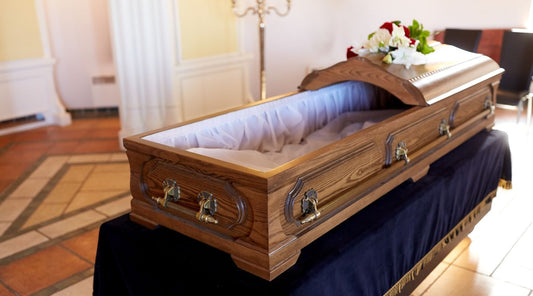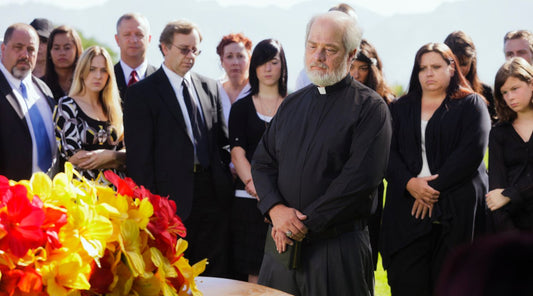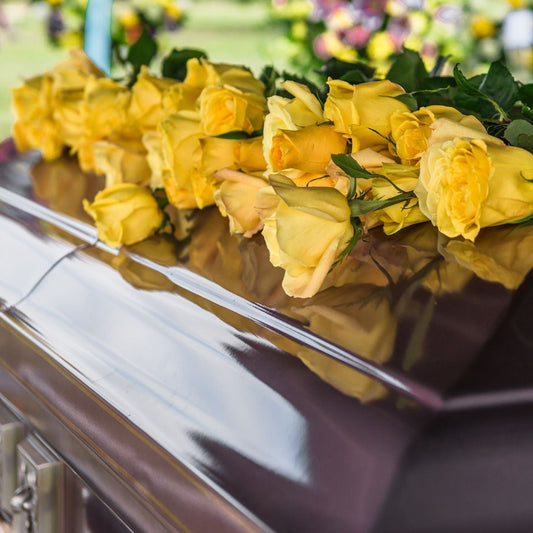
Catholic funeral. Traditions and all to know about Catholic Funerals.
We get to honor a loved one's life at a funeral. It is a time to respect their religious rituals by performing them and saying our goodbyes.
Many cultures and religions, including the Catholics, perform unique customs and rituals to mark a person's passing.
If you want to learn how a traditional catholic funeral service is conducted, this article is for you.

Catholic Funeral Service Traditions
There are regional and cultural differences in Catholicism. However, they have a common faith that God created an afterlife for humans. Catholics believe death is a medium to travel to the afterlife, which consists of heaven, purgatory, and hell.
The death of a person signifies positivity because of Jesus Christ's sacrifice for the world. According to the Catholic scripture, you go to heaven and get eternal life if you believe in Jesus Christ. Many also believe in His second coming when dead bodies will resurrect.
Catholic funerals follow a series of rites upon someone's passing. It typically consists of 3 ceremonies: wake, funeral mass, and committal. How Long Is A Catholic Funeral? Compared to Christian funerals, Catholic funerals perform more rites.
Wake
Also called the vigil service or rosary service, the wake is the time after someone's death when the family and friends of the dead person pay their respects. They gather at the family home, the church, or a funeral home for the prayer vigil.
The role of this service is for loved ones to reconcile with the decedent and say prayers. The family members decide whether or not to keep the casket open.
A priest leads the prayer vigil service, reads scriptures from the Old Testament, and prays. People also read eulogies and poetry and sing songs during the wake. It is a chance for the family members to gather, mourn, and comfort each other.
Funeral Mass
Following the wake, the Catholic funeral mass, also known as the requiem mass formal ceremony, takes place in the church. It is of huge importance for Catholics because it reflects the departed soul entering the afterlife and returning to God.
It is also a time for family and friends to pray for the soul of the deceased.
This Catholic funeral ceremony starts with a procession when the pallbearers carry the urn or closed casket into the church. It symbolizes the person returning to God.
Once the casket is placed inside the church (at the altar), the priest sprinkles Holy Water on it. He will also place a crucifix or Bible and mass cards on the casket as a Catholic funeral mass tradition.
The priest then reads at least one reading from the Old or New Testament and offers a Holy Communion and a eulogy.
It is followed by additional blessings and a recession when the casket closed by the funeral director is carried to a hearse or a funeral coach. The mourners accompany the deceased to the gravesite or cemetery.
The funeral rite of a Catholic funeral mass consists of a procession, sprinkling the urn or casket with holy water, reciting Bible scriptures by the priest, eulogy by a family member (also called the Final Commendation), offering wine and bread, and ending with a recessional.
While the prayers and readings at the Catholic funeral are particular to the deceased's soul, the ritual is traditional.

Committal
The committal is the final act of the Catholic funeral tradition. It means committing the deceased to their final resting place. This is the time when more Catholic funeral rites occur.
If the person who died chose burial, the committal is when their casket is placed below the ground. During this time, the priest reads scriptures and waves incense to represent the deceased's prayer offerings to God.
The close family members and friends gathered for the cemetery services to say their final prayer. And when the casket lowers to the ground, the Catholic priest quotes, "ashes to ashes, dust to dust."
The Catholic Church allows cremation. However, you cannot keep the cremated remains or the ashes at home or scattered. Since Catholics believe in the soul's resurrection on judgment day, keeping the deceased's remains in one place is crucial.
The dead person should be buried in a proper burial ground, like a mausoleum, cemetery, or memorial forest.
Where Does A Catholic Funeral Take Place?
A Catholic funeral mass is traditionally held at the decedent's local church or funeral home. Performing the funeral mass in the church gives the loved ones an opportunity to place the decedent into God's care and offer special prayers and communion.
Not very long ago, Christian funerals were traditionally held within 3 days. However, this Catholic tradition has become more lenient now that many families live far apart.

Who Attends The Funeral?
Close family, friends, extended relatives, church parishioners, and anyone with a relation to the decedent can be at the funeral mass.
It is common to release an obituary in the local daily, which notifies about the ceremonies. So, there's no need to make individual announcements.
Who Participates At The Funeral?
A deacon or priest with an assistant, funeral directors, assistants, and alter attendants leads the funeral ceremony. Family members, friends, ushers, and pallbearers are the other participants in the funeral mass.

What Do The Catholics Believe About Death?
According to the Catholic faith, there's life after death. Depending on a person's life actions, their soul goes to purgatory, heaven, or hell.
Purgatory is a state or place where sinners' souls make amends for their sins to go to heaven. In Catholic doctrine, even a person who has atoned for their sins when they were alive can't go to heaven directly.
It was a popular belief that ghosts we encounter in the living world were dead spirits needing people to finish their tasks to get a place in heaven.
Several ghost stories of the medieval period feature living people pressured to fulfill obligations for the spirits of dead people confined in purgatory. However, this doctrine was condemned by the Protestant Reformation in the 16th Century. The idea of purgatory is a significant difference between Protestants and Catholics.
Not every modern Catholic thinks purgatory is real, but the Catholic Church still believes in it. Many Catholic funeral traditions, like vigil services and requiem masses, are an outcome of the idea of purgatory.
What Is The Format Of A Catholic Funeral?
It depends on whether a requiem mass is conducted, which includes Holy Communion and Eucharistic Prayer. Not every Catholic funeral performs requiem masses, but the church encourages it.
If the church does not receive the coffin by the eve of the funeral, the priest will greet it on the day of the funeral at the door. Upon reaching the door, the priest procession will take place when he will sprinkle Holy Water on the coffin and bring it to the church.
Catholic funerals usually last about forty minutes. If it includes a Mass, it will exceed an hour. Famous funerals like Pope John Paul II, who died on April 2, 2005, had a Catholic funeral.
Catholic Cremation or Burial
A Catholic cremation or burial begins with a committal at the gravesite, columbarium, or mausoleum. Also known as the Catholic Rite of Committal, this service is conducted by a deacon or an ordained priest who blesses the site, leads the family in prayer, and recites the Lord's Prayer.
Traditionally, a burial follows Catholic funerals, and embalming the body is perfectly acceptable. Pope Paul VI dictated that the cremation of a Catholic is acceptable. Their ashes should be inurned and preserved in a Church-approved columbarium or buried in a plot in the cemetery.
Pope Francis dictated that ashes should never be kept at home or scattered. There isn't a prescribed mourning time for Catholics. However, some families can conduct a memorial service and communion for up to 6 months.

What Is The Catholic Funeral Etiquette?
You'll see people generally wearing smart, dark clothing in a catholic funeral home. Men traditionally wear a black suit and tie, while women also wear a black suit or dress.
Those attending a Catholic funeral are expected to come in modest clothing. However, it isn't required of you to cover your head.
Some open-minded churches allow colorful clothing at church funeral. But when in doubt, don't wear overly casual clothes like sportswear, jeans, trainers, and hoodies.
Whether you go to a Muslim or a Catholic funeral, funerals are a somber occasion. After the final prayers are said, and the Catholic service rite ends, it is expected of attendees to sit beside the mourners and comfort them.
During prayers, you might notice some people kneeling. But it's okay to stay seated with your head bowed down. People also might stand when singing hymns, so you can stand, too, unless you're physically unable.
There's no need to take part in Holy Communion for non-Catholic people. But you can join the others in the procession and receive the priest's blessings if you wish to.
Not all Catholic funerals will exactly be the same, as there may be a few differences depending on the circumstances. Unless the deceased's final wishes are against Catholic doctrine, they are usually respected.
Common Catholic Funeral Tradition Questions
Do Catholics Leave The Casket Open Or Closed?
There is no strict rule regarding leaving the casket open or closed. So the decision is up to the deceased's family.
Is Cremation Allowed In Catholicism?
A deceased Catholic person can be cremated. However, the cremated remains shouldn't be scattered or split. It should be interred or buried in a holy place. You also shouldn't store cremains in jewelry or anywhere at home.
Are Songs Played In A Catholic Funeral?
Every Catholic church typically selects the songs and hymns to be played or sung at a funeral. You can talk to the leaders if you wish to select a particular song for the funeral service.
Can You Give Flowers In A Catholic Funeral?
You can send or bring flowers to the funeral or family home. It's better not to send them to the church because Catholic churches allow only a limited amount of flowers. You should also note that flowers are not allowed in the church during certain times, like Lent.


